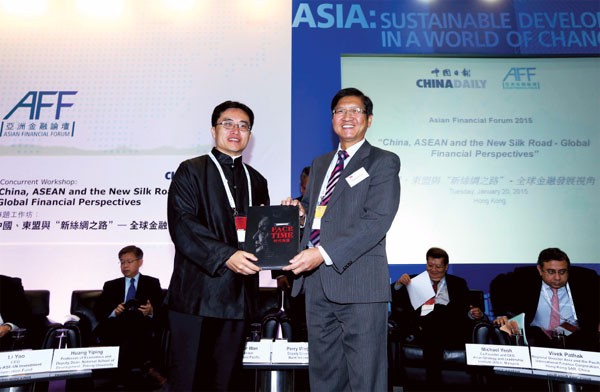2015-01-23
Ben Yue

“The (ASEAN Economic Community) is just one mission accomplished. People wonder what’s next after 2015,” said Michael Yeoh, CEO of the Malaysia-based Asian Strategy and Leadership Institute. He made his comments at a China Daily roundtable that took place in Hong Kong on Jan 20 with the theme China, ASEAN and the New Silk Road — Global Financial Perspectives. Experts speaking at the roundtable agreed that the Association of Southeast Asian Nations (ASEAN) needs new plans for the post-2015 period after the realization of the AEC, a single regional market, by the end of this year. Developing the post-2015 vision is very important, Yeoh said. Malaysia as the regional bloc’s chair for 2015 has identified the creation of a “people-centered ASEAN” as the central element of this chairmanship. There are two things Malaysia hopes to accomplish as chair of ASEAN, he said. “One is trying to engage the people of ASEAN more — focusing on a people-centered ASEAN — in developing a post-2015 vision,” Yeoh said. The other is to help fast-track the AEC process despite the fact that the 10 member countries are at different stages of development. According to the AEC scorecard, a monitoring mechanism to track the progress of the regional community, 84 percent of the AEC target has been achieved. While this is commendable, it also means that there is still a lot of work left to be done. “I think the prospects for ASEAN are getting better with the realization of AEC, (which is expected) by December of this year,” Yeoh said. “Now, ASEAN is already the seventh biggest economy in the world, and it’s been projected that by 2050, ASEAN can become the world’s fourth biggest economy.” In December, the leaders of the bloc signed the Nay Pyi Taw Declaration on the ASEAN Community’s Post-2015 Vision, which determines to “shape a bold and forward-looking future for ASEAN which will enhance and strengthen the ASEAN Community and enable the realization of a politically cohesive, economically integrated, socially responsible, and a truly people-oriented, people-centered and rules-based ASEAN”. Although little has been revealed about the details of the plan, Le Luong Minh, secretary-general of ASEAN, said earlier that the bloc’s future goals after 2015 include doubling the region’s combined GDP while halving the number of ASEAN people living in poverty by 2030. AEC is a process, rather than an event, Le said. The ASEAN Integration Monitoring Report, jointly produced by the ASEAN Secretariat and the World Bank, suggests that beyond 2015, ASEAN should continue to be a “facilitator of better integration of its members’ economies into the global trading system and pursue an open regionalism agenda”. The report also notes the significance of looking into “streamlining rather than eliminating” non-tariff measures to make them more targeted, simple and effective, while minimizing any trade-restricting impact. “2015 is the year of final exam for ASEAN. The accomplishment of AEC is not only important to ASEAN, but also important to the regional economy and the global economy,” Xu Ningning, executive president of the China-ASEAN Business Council, told delegates at the roundtable. “Reaching the AEC target is not easy. It depends on the 10 countries working together and also needs support from countries from the outside.” Xu said that China’s Maritime Silk Road initiative — which links China to ASEAN, South Asia, the Middle East, North Africa and Europe — will benefit ASEAN in terms of building the AEC and its future economic development after the realization of the regional economic community. China’s trade with ASEAN grew 8.3 percent last year, significantly higher than China’s overall trade growth of 3.4 percent over the same period, Xu said. He pointed out that China’s contribution to the AEC was mainly focused on building physical connectivity and improving related infrastructure such as ports, railways and roads. State-owned companies such as China Harbor Engineering have invested in big connectivity projects in ASEAN. There are also special funds to finance those projects such as the 3 billion yuan ($483 million) China-ASEAN Maritime Cooperation Fund and the $40 billion New Silk Road Fund. Perry Warjiyo, deputy governor of Bank Indonesia, said that Indonesia is investing in major infrastructure projects in the next five years, which include building 15 new airports and expanding 40 existing airports and 15 seaports. Warjiyo said ASEAN’s largest economy will develop its eastern part to link with the Maritime Silk Road, and will build over 3,000 kilometers of roads and railways. Indonesia’s infrastructure projects will be financed by the government and the private sector. Warjiyo said Indonesia hopes to invite more investors from countries including China, Japan, South Korea and the US. Investors who want to invest in ASEAN should consider Hong Kong as a gateway, said Raymond Yip, deputy executive director of the Hong Kong Trade Development Council (HKTDC), adding that Hong Kong is well positioned to play an important role in the new economic dynamic of Asia. “The ASEAN economy as an economic bloc already represents our second largest trading partner, with total bilateral trade reaching $96.3 billion last year,” he said. “Meanwhile, some 500 ASEAN companies already have presences in Hong Kong.” HKTDC data show about 10 percent of trade between the Chinese mainland and ASEAN went through Hong Kong last year. Yip said that Hong Kong will continue to reach the mainland and ASEAN markets, engineering new development and cooperation opportunities in industries such as retail, logistics and infrastructure financing. Hong Kong needs to stay relevant and must not be marginalized in the overall picture, said Li Yao, CEO of the China-ASEAN Investment Cooperation Fund. The Hong Kong-based fund has already raised $1 billion, which has been invested in ASEAN projects such as Cambodia’s national fiber optic cable network, Thailand’s largest port, Asia’s largest potash mine in Laos and Indonesia’s largest ferronickel smelter. These undertakings act as an example of the diversity of infrastructure and other projects in the region even as the establishment of the AEC draws near. benyue@chinadailyhk.com http://www.chinadailyasia.com/2015-01/23/content_15218088.html